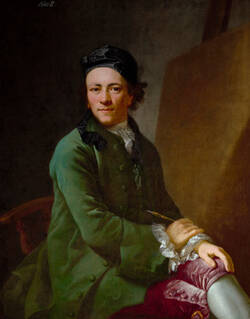In 1766 the 29-year-old Swiss artist Graff submitted this self-portrait in support of his application for a position as court painter in Dresden. The artist presents himself as young, dashing and confident, seated in front of an as yet empty canvas. A characteristic feature are his alert eyes: is he looking at himself in a mirror? Or at a person whose portrait he intends to paint? With his keen eye, Graff sought to capture his subject’s soul or essence, not merely to reproduce their appearance.
Further Media
In his first years as painter to the Electoral court in Saxony, Graff received a fixed salary of 400 thaler a year – not especially generous. Around 1800, with a bit of luck, a craftsperson or artisan could hope to earn that much as well. In 1789, Graff was appointed as professor of portrait painting – and enjoyed a hefty pay rise pushing his salary to an annual 700 thaler. In return, he had to paint a portrait for the court every year and train at least one apprentice painter. Any work beyond this requirement was to be paid extra. Graff had a sliding scale of fees – for example, 50 thaler for a half-length portrait without hands, and 100 thaler for a similar portrait with hands, since hands were especially complicated to paint. Of course, the fee for a full-length portrait was even higher. Anton Graff was an exceptionally productive artist, executing over 2000 portraits, and became very wealthy. When he died in 1813, he left his children 40,000 thaler – and with the equivalent amount today, he would have been a rich man.
In his self-portraits, Graff nearly always painted himself with the tools of his craft. Here, though, he is not holding an artist’s palette and brushes. Instead, the holder in his hands could take various colours of chalk or a graphite stick. With this device, Graff sketched the underdrawing on the canvas before he started the painting process. With just the holder in his hands, Graff could be mistaken for a draughtsman, but the large canvas behind him unequivocally signals his profession as an artist.
When Graff painted faces, he particularly emphasised the rendering of the eyes – just as he did especially in his self-portraits. After all, it was his eyes which allowed him to perceive his subject and capture it in paint. Graff added white highlights to the pupils – a device making the eyes look almost magically alive. Moreover, in his portraits, the figures nearly always gaze out at us directly. In this youthful self-portrait, for instance, Graff’s gaze is particularly intense. He was said to look at his sitters for portraits with such a piercing gaze that some of them could hardly bear it.
- Location & Dating
- 1765
- Material & Technique
- Oil on canvas
- Dimenions
- 101,3 x 78,8 cm
- Museum
- Gemäldegalerie Alte Meister
- Inventory number
- Gal.-Nr. 2166

